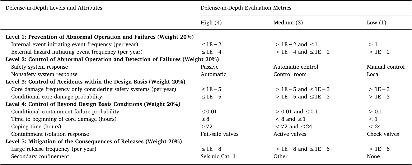Integrating quantitative defense-in-depth metrics into new reactor designs
- NuScale Power, LLC, Corvallis, OR (United States)
Risk-informed, performance-based (RIPB) methods have progressed to the point where high-level guidance can be used to augment traditional, deterministic, nuclear safety design practices in areas important to nuclear reactor safety. This paper describes an approach for augmenting the traditional defense-in-depth (DID) qualitative approach with quantitative risk information from a plant-specific probabilistic risk assessment (PRA) in a way that is structured, can be applied on a consistent basis, and allows for clear acceptance criteria. Adding performance-based targets that should be achieved is expected to result in safer and more economical plant designs. Evaluations of DID can be conducted throughout the design process as well as in support of design certification and operating license applications to identify where defense protections could be enhanced or relaxed. Consistent with the United States Nuclear Regulatory Commission's policy statement encouraging greater use of PRA to improve safety decision making and regulatory efficiency, this scenario-based DID method can be used to evaluate changes and overall plant design as part of the normal design control process. Although the RIPB method presented in this paper was developed for application to advanced passive light water reactor designs, the metrics could be tailored to other reactor designs. This risk-informed approach to DID helps to ensure that public and worker risk insights are integrated into the design process holistically.
- Research Organization:
- NuScale Power, LLC, Portland, OR (United States)
- Sponsoring Organization:
- USDOE Office of Nuclear Energy (NE)
- Grant/Contract Number:
- NE0000633
- OSTI ID:
- 1501537
- Journal Information:
- Nuclear Engineering and Design, Vol. 330, Issue C; ISSN 0029-5493
- Publisher:
- ElsevierCopyright Statement
- Country of Publication:
- United States
- Language:
- English
Web of Science
Similar Records
Modernization of Technical Requirements for Licensing of Advanced Non-Light Water Reactors: Risk-Informed and Performance-Based Evaluation of Defense-in-Depth Adequacy
Utilization of the LMP Methodology in Support of the VTR Conceptual Safety Design Report







